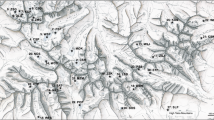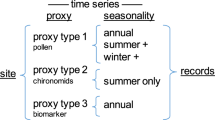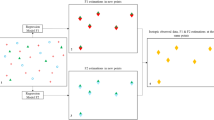Abstract
This paper presents a new method (moving-windows) that optimizes diatom-based paleolimnological reconstructions of past environmental conditions from supra-regional training sets. The moving-window method identifies the best number of nearest neighbours (window size) from a merged supra-regional EDDI and local (MV) training set (n = 429) for each fossil diatom assemblage and the best type of transfer function (ML, WA-PLS) based on the error statistic of each transfer function (highest cross-validated R 2, lowest cross-validated average bias, maximum bias and RMSEP). At first we evaluated the moving-window approach by comparing measured TP-values with inferred TP-values using both the moving-window approach and the WA-PLS method. The relative errors of the moving-window approach were not significantly different for 208 samples that had an error <15 μg/l TP using the WA-PLS method. However, for the remaining 221 samples with errors >>15 μg/l TP using the WA-PLS method, the moving window approach significantly reduced the relative error of the inferred TP levels. Secondly, the moving- window approach was used to reconstruct epilimnetic total phosphorous (TP) for Lake Dudinghausen, Lake Rugensee, Lake Tiefer See and Lake Drewitzer See (Northern Germany) using both the supra-regional EDDI training set and a local training set from Northern Germany (MV training set). The moving-window inferred TP-levels of the four study lakes were compared with published reconstructed TP-values and with inferred TP-values based on the local MV training set. Overall, the moving-window and the published TP-trends agree well with each other. However, the moving-window reconstructions generally indicated lower TP-levels throughout the past ∼5,000 to 12,000 years, including past maxima. Thus, the moving-window method seems to generate more realistic absolute TP levels due to the optimized window size (highest number of modern analogues, best error statistics). The identification of more realistic absolute historic TP-values is important for the validation of reference conditions for inland waters. This study also demonstrates that a robust local training set may, similar to moving-window training sets, also lead to reliable reconstructions, if the geological settings of the local training set lakes and the study lakes are similar.






Similar content being viewed by others
References
Adler S, Hübener T (2007) Spatial variability of diatom associations in surface lake sediments and its implications for transfer functions. J Paleolimnol 37:573–590
Battarbee RW, Jones VJ, Flower RJ, Cameron NG, Bennion H, Carvalho L, Juggins S (2001) Diatoms. In: Smol JP, Birks HJB, Last WM (eds) Tracing environmental change using lake sediments, vol 3. Kluwer, Dordrecht, pp 155–202
Battarbee RW, Monteith DT, Juggins S, Evans CD, Jenkins A, Simpson GL (2005) Reconstructing pre-acidification pH for an acidified Scottish loch: a comparison of palaeolimnological and modeling approaches. Environ Pollut 137:135–149
Bennion H, Juggins S, Anderson N J (1996) Predicting epilimnetic phosphorus concentrations using an improved diatom-based transfer function, and its application to lake eutrophication management. Environ Sci Technol 30:2004–2007
Birks HJB (1995) Quantitative paleoenvironmental reconstructions. In: Maddy D, Brew JS (eds) Statistical modeling of Quaternary science data. Technical guide 5. Quaternary Research Association, Cambridge, pp 161–254
Birks HJB (1998) Numerical tools in paleolimnology—progress, potentialities and problems. J Paleolimnol 20:307–332
Birks HJB, Line JM, Juggins S, Stevenson AC, ter Braak CJF (1990) Diatoms and pH reconstruction. Philos Trans Roy Soc B 327:263–278
Bradshaw EG, Rasmussen P, Odgaard BV (2005a) Mid- to late holocene land-use change and lake development at Dallund So, Denmark: synthesis of multiproxy data, linking land and lake. Holocene 15/8:1152–1262
Bradshaw EG, Rasmussen P, Nielsen H, Anderson NJ (2005b) Mid- to late holocene land-use change and lake development at Dallund So, Denmark: trends in lake primary production as reflected by algal and macrophyte remains. Holocene 15/8:1130–1242
Crawley MJ (2002) Statistical computing—an introduction to data analysis using S-plus. Wiley & Sons, Chichester
Dapples F, Lotter AF, van Leewen FN, van der Knaap WO, Dimitriadis S, Oswald D (2002) Paleolimnological evidence for increased landslide activity due to forest clearing and land-use since 3600 cal BP in the western Swiss Alps. J Paleolimnol 27:239–248
Dreßler M, Hübener T (2003) Diatomeenuntersuchungen zur Trophieentwicklung des Rugensees nördlich von Schwerin (Mecklenburg-Vorpommern) während des Holozäns. In: Almuth Schülke: Landschaften – Eine archäologische Untersuchung der Region zwischen Schweriner See und Stepenitz, Mecklenburg-Vorpommern, vom Mesolithikum bis zur Frühslawischen Zeit. Diss. Univ. Kiel
Dreßler M, Selig U, Dörfler W, Adler S, Schubert H, Hübener T (2006) Environmental changes and the migration period in Europe by the example of Lake Dudinghausen (northern Germany). Quatern Res 66:25–37
Hastie T, Tibshirani R (1990) Generalized additive models. Chapman and Hall, London
Hastie T, Tibshirani R, Friedman J (2001) The elements of statistical learning. Springer, New York
Hill MO (1973) Diversity and evenness: a unifying notation and its consequences. Ecology 54:427–432
Hübener T, Dörfler W (2004) Reconstruction of the trophic development of the Lake Krakower Obersee (Mecklenburg, Germany) by means of sediment-diatom- and pollen-analysis. Stud Quatern 21:101–108
Juggins S (2003) Europaen Diatom Database Iniziative (EDDI), http://craticula.ncl.ac.uk/Eddi/jsp/index.jsp
Juggins S, Anderson J, Bennion H, Lotter AF, Hausmann S, Rioual P, Ryves D, Schmidt R, Wunsam S (2000) Does merging regional diatom-based nutrient transfer functions and training sets lead to more accurate and precise hydrochemical reconstructions? 8th International Paleolimnology Symposium, Kingston
Kalbe L, Werner H (1974) Das Sediment des Kummerower Sees. Untersuchungen des Chemismus und der Diatomeenflora. Int Rev Ges Hydrobiol 596:755–782
Köster D, Racca JMJ, Pienitz R (2004) Diatom-based inference models and reconstructions revisited: methods and transformations. J Paleolimnol 32:233–246
Mc Gowan S, Leavitt PR, Roland IH, Anderson NJ, Jeppesen E, Odgaard BV (2005) Controls of algal abundance and community composition during ecosystem state change. Ecology 86:2200–2211
Lotter AF, Birks HJB (2003) The Holocene palaeolimnology of Sägistalsee and its environmental historya synthesis. J Paleolimnol 30:333–342
Ohle W (1973) Rasante Eutrophierung des Großen Plöner Sees in frühgeschichtlicher Zeit. Naturwissenschaften 60:47
Overpeck JT, Webb T, Prentice IC (1985) Quantitative interpretation of fossil pollen spectra: dissimilarity coefficients and the method of Modern Analogs. Quatern Res 23:87–108
Racca JMJ, Prairie YT (2004) Apparent and real bias in numerical transfer functions in palaeolimnology. J Paleolimnol 31:117–124
Racca JMJ, Greory-Eaves I, Pienitz R, Prairie YT (2004) Tailoring palaeolimnological diatom-based transfer functions. Can J Fish Aquat Sci 61:2440–2454
Sander-Johansson L, Amsinnck SL, Bjerring R, Jeppesen E (2005) Mid- to late Holocene land-use change and lake development at Dallund So, Denmark: trophic structure inferred from cladoceran subfossils. Holocene 15:1143–1151
Schönfelder I, Gelbrecht J, Schönfelder J, Steinberg CEW (2002) Relationship between littoral diatoms and their chemical environment in northeastern German lakes and rivers. J Phycol 38:66–82
Schwarz A (2006) Rekonstruktion der Entwicklung des Schulzensees und des Tiefen Sees (Mecklenburg-Vorpommern) seit dem Spätglazial mittels Diatomeenanalyse unter besonderer Berücksichtigung der Trophiegeschichte. Greifsw Geogr Arbeiten 41:1–166
Simpson GL, Shilland EM, Winterbottom JM, Keay J (2005) Definingreference conditions for acidified waters using a modern analogue approach. Environ Pollut 137:119–133
Smol JP, Birks HJB, Last WM (eds) (2001) Tracking environmental change using lake sediments, vol. 3: terrestrial, algal and siliceous indicators. Kluwer Academic Publishers, Dordrecht
Stoermer EF, Smol JP (eds) (1999) The diatoms: applications for the environmental and earth sciences. Cambridge University Press, Cambridge
ter Braak CJF (1995) Non-linear methods for multivariate calibration and their use in paleoecology: a comparison of inverse (K-Nearest Neighbours, PLS and WA-PLS) and classical approaches. Chemometr Intell Lab 28:165–180
ter Braak CJF, Śmilauer P (2002) CANOCO Reference manual and CanoDraw for windows user’s guide. Software for canonical community ordination (version 4.5). Microcomputer Power, Ithaca, New York
ter Braak CJF, van Dam H (1989) Inferring pH from diatoms: a comparison of old and new calibration methods. Hydrobiologia 178:209–223
Werner P, Smol JP (2006) The distribution of the diatom Cyclotella comensis in Ontario (Canada) lakes. J Paleolimnol 130:373–391
Wood S (2006) Generalized additive models. An introduction with R. Chapman and Hall, London
Acknowledgements
We would like to thank Petra Werner for translating the manuscript and for giving valuable comments. Also the reviewers (H.J.B. Birks and an anonymous one) were giving important suggestions.
Author information
Authors and Affiliations
Corresponding author
Rights and permissions
About this article
Cite this article
Hübener, T., Dreßler, M., Schwarz, A. et al. Dynamic adjustment of training sets (‘moving-window’ reconstruction) by using transfer functions in paleolimnology—a new approach. J Paleolimnol 40, 79–95 (2008). https://doi.org/10.1007/s10933-007-9145-7
Received:
Accepted:
Published:
Issue Date:
DOI: https://doi.org/10.1007/s10933-007-9145-7




